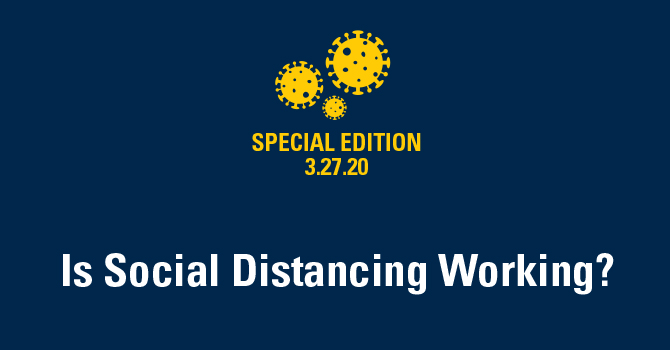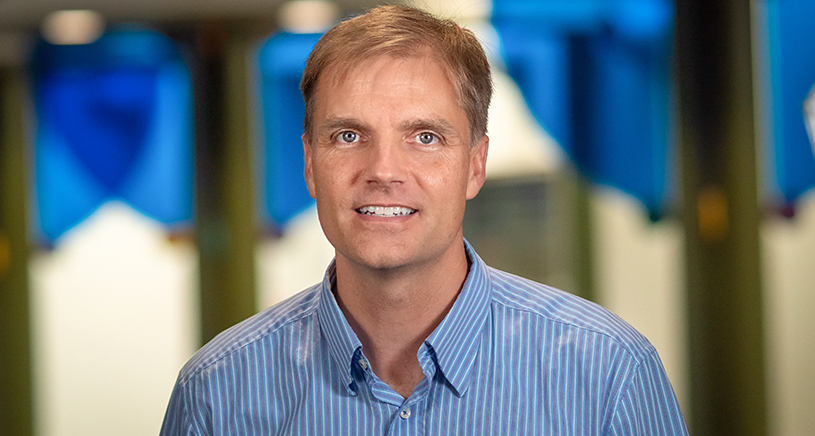Is Social Distancing Working?

Social distancing is a tried and true preventive step in public health to slow the transmission of infectious diseases. As people around the United States and around the world practice social distancing and pay attention to directives to stay home during the coronavirus pandemic, we're still seeing case counts go up. Is this an indictment of social distancing? David Hutton, associate professor of Health Management and Policy at the University of Michigan School of Public Health, discusses what we're likely to see with continued social distancing.
Listen to "Is Social Distancing Working? 3.27.20" on Spreaker.
|
Subscribe and listen to Population Healthy on Apple Podcasts, Spotify, Google Podcasts, iHeartRadio, YouTube or wherever you listen to podcasts! Be sure to follow us at @umichsph on Twitter, Instagram, and Facebook, so you can share your perspectives on the issues we discussed, learn more from Michigan Public Health experts, and share episodes of the podcast with your friends on social media. |
Speaker 1: For the past two weeks, most of us have begun social distancing: staying at home as much as possible to avoid contracting or spreading coronavirus. One question that doesn't have a clear answer is, “When will we be able to go back to normal?”. We've made all these sacrifices and we want to know if they're making a difference.
Hello and welcome to Population Healthy a podcast from the University of Michigan School of Public Health. This episode as part of a series of special editions of our Podcast, focusing on the ongoing coronavirus pandemic. Despite our efforts, we are seeing numbers of cases continue to shoot up each day. So does that mean social distancing isn't Working? Not at all. And to better understand what's going on, we talked with David Hutton, an associate professor of Health Management and Policy at the University of Michigan School of Public Health and an expert in mathematical modeling of diseases and pandemic planning.
Hutton: When we look at the experience in China, specifically the Hubei Province and Wuhan, and then we look at places like Italy and potentially other places in Europe, what I've been seeing and looking at that is, first of all, they're on this exponential growth in numbers of cases and it’s very scary, they've implemented this social distancing, which has been quite restrictive. I think that's a good thing.
But even after they implemented the social distancing, the epidemic trajectory continued to rise and the number of new cases every day, more and more new cases, more cases than yesterday, more new cases than yesterday for about two weeks.
And I gotta tell you, that's kind of scary. You think you're doing the right thing. You said “Hey wait, I've been in my home for a week. I'd been confined on my own for two weeks.” And yet the new cases, keep on rising, and rising and rising.
But the good news is that about after two weeks or so, it looks like the number of new cases per day do seem to be peaking, plateauing, and then declining. And I think there's a good epidemiological reason for that. It takes almost a week or so before symptoms develop, and then it probably takes another few days for someone to go to the hospital, another few days for them to actually get tested and get their test results back. So there's gonna be a natural lag or delay between when you actually implement successful interventions to reduce the spread of disease and between when you see the actual number of reported cases peak, or begin to drop.
It might be discouraging in the first few weeks of social distancing. And you'll see the cases rise and rise and rise and then it'll get kind of scary, but I think eventually those numbers will drop. It seems like these social distancing interventions, these other countries have proved that they can be effective at reducing the page number of cases,
Speaker 1: Many are wondering what it will look like when the number of new cases per day does eventually drop. Will we be able to get back to our normal day-to-day activities right away?
Hutton: If the social distancing is effective, and I think it will be, that's a very good thing and we'll be reducing a lot of unnecessary infections and cases and as people say, flatten the curve. But if we're really effective, I think and hopefully we will be, only a small fraction of the population will become infected over the next couple of months, let’s say. And that's a very good thing that we're reducing the number of total people infected. But, it does mean that if we lift the social distancing interventions too early and April 1st we have a football game in the Michigan Stadium with one hundred thousand people in it, that's not gonna be a good thing because of those one hundred thousand people in the stadium, 95% or more are gonna still be susceptible to the virus. And so we won't have achieved what's called herd immunity, and so the virus can still kind of spark and explode in that population again.
So once we finish this round of social distancing in the next few weeks and months, we need to be really careful as we lift these social distancing measures to make sure that the virus doesn't take hold again and run out of control again.
Speaker 1: This has been a special edition of Population Healthy, a podcast from the University of Michigan School of Public Health. During the ongoing coronavirus pandemic, we’ll work to bring you analysis from our community of experts to help you understand what this public health crisis means for you. To stay up-to-date in between special edition episodes, be sure to check out our website publichealth.umich.edu, subscribe to our Population Healthy newsletter at publichealth.umich.edu/news/newsletter and follow us on Twitter, Instagram, and Facebook @umichsph.
In This Episode
 David Hutton
David Hutton
Associate Professor, Health Management and Policy
David Hutton is an associate professor of Health Management and Policy with a background in economics, engineering, and health policy modeling. He is an expert in mathematical modeling of diseases and pandemic planning, and is interested in interventions with uncertain or complex outcomes. Learn more.
